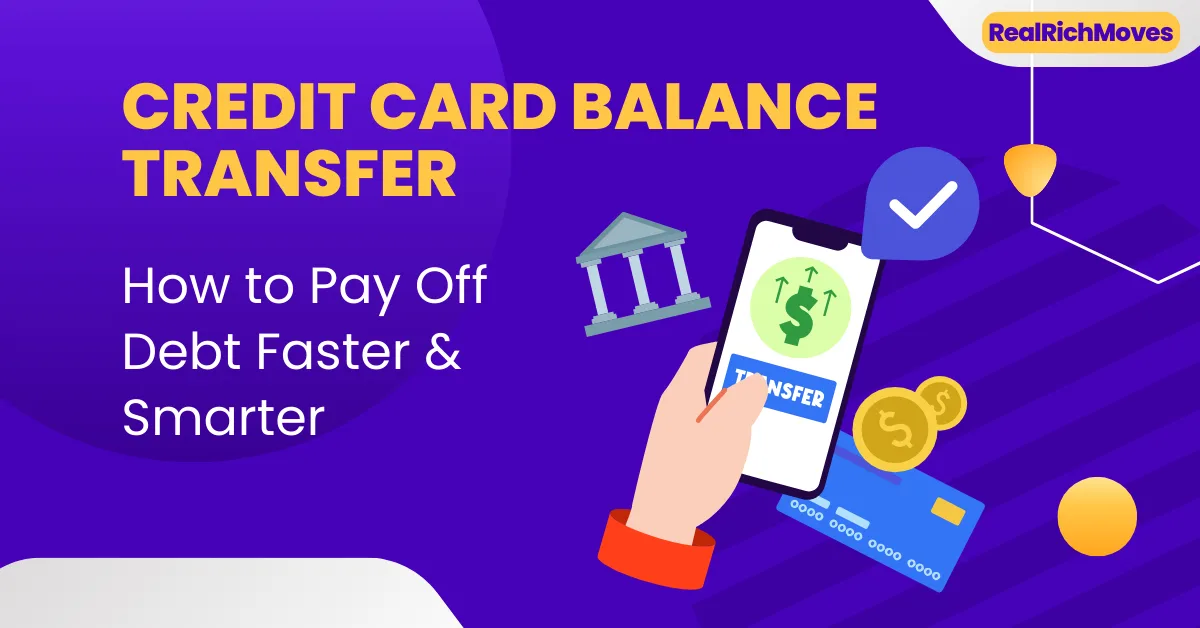Introduction
Hey fam! Let’s talk about a financial tool that can be either your best friend or your worst enemy: credit card balance transfer. You might have heard people talking about it as a way to pay off debt faster, but is it really a magic solution, or is it just another trap? That’s what we’re diving into today, to explore the reality behind a credit card balance transfer.
I know, credit card debt can be super stressful, and it is very tempting to look for any option to get out of it. That’s why today we are exploring this topic of balance transfers. This post will give you a balanced perspective, and will help you decide if a credit card balance transfer is actually right for you, or if it is just a trick that will end up costing you more money.
This guide is designed to help you understand how a credit card balance transfer works, and to help you evaluate if it is a suitable choice for your situation. So, let’s get started and cut through all the hype!
Now that you have a basic understanding of what this is about, let’s start with the basics.
Understanding Credit Card Balance Transfer: The Basics
Okay, before we get into the pros and cons, let’s first talk about the fundamentals. What exactly is a credit card balance transfer and how does it all work? It’s time to understand the basics of this financial tool, so you can make better decisions in the future.
What is a Balance Transfer?
A balance transfer is when you move your existing credit card debt from one card to another, and you are usually doing this to take advantage of a lower interest rate or better terms. It’s a way to consolidate your debt, and also to lower your interest rates, to pay off your debt faster. It’s crucial to know that a balance transfer is not a way to create more debt, it is a way to manage your existing debt more effectively.
It’s important to understand that a balance transfer is not some kind of a magical solution to all your debt problems, it is a tool that needs to be used wisely. You have to use this responsibly, or it will end up hurting your finances. Understanding this will help you in using a credit card balance transfer wisely.
How Balance Transfers Work
The process of a credit card balance transfer is generally simple. You start by applying for a new credit card that offers balance transfer options. If approved, you can transfer your existing credit card balances to the new card. Most of the time, the credit card company will pay off the balance from your old credit card directly. Then, you start paying off your balance on your new card.
It’s important to understand all these different steps, and to also read all the terms and conditions before you apply for a new credit card for the purpose of a balance transfer. Understanding this will give you a better perspective of how a credit card balance transfer works.
Key Terms to Know
There are some important terms that you need to understand, before applying for a credit card balance transfer. The most important one is the introductory APR (Annual Percentage Rate). This is the low interest rate that you will be getting at the beginning.
Then, there is the transfer fee, which is what you have to pay for every balance transfer, then there is the balance transfer limit, which is the maximum amount of debt that you are allowed to transfer. And of course you have to look into the length of the intro period, which is how long you will be getting that low intro APR.
It is absolutely crucial to understand all of these terms, to make sure you know what you are getting into, before you apply for a credit card balance transfer. Understanding the credit card terms will help you make more informed decisions, and truly understand the basics of a credit card balance transfer.
Now that we know the basics of a balance transfer, let’s discuss the pros and cons.
Okay, now that we’ve laid the groundwork, let’s get into the pros and cons of balance transfers. Because while they can be useful tools, they’re definitely not for everyone. We need a balanced approach to really understand how they can help or hurt our finances.
The Pros and Cons of a Balance Transfer
It is time to cut through the hype and to give you a clear picture of all the potential benefits and the possible drawbacks of a credit card balance transfer. It is always a good idea to have a balanced approach, when you are trying to make any financial decisions.
The Pros: Why a Balance Transfer Can Be a Smart Move
One of the biggest benefits of a balance transfer is the possibility of lowering your interest rates, which can help you save a lot of money in the long run. It can also lead to lower monthly payments, which can also free up some money in your budget. And if you are using a balance transfer strategically, you can also pay off your debt faster, which can get you out of debt faster.
If you are doing everything correctly, then a balance transfer can definitely help you avoid the minimum payment trap, and you can pay off your debt faster and cheaper. The key is to use balance transfers responsibly, and only if it fits your situation.
The Cons: The Potential Pitfalls
But there are also some potential pitfalls that you need to be aware of. Most balance transfer credit cards come with transfer fees, which can sometimes be around 3-5% of the transfer amount. Also, the low introductory interest rates do not last forever, and after that intro period, the interest rates can jump up pretty high.
If you are not disciplined, or if you are having trouble with spending habits, then a balance transfer might just make your debt problems even worse. Because, if you start accumulating debt on your old card again, then you are in double trouble. So it is very important to understand that a credit card balance transfer is not a magical solution, and you still need to be responsible with your finances.
The Real Cost of a Balance Transfer
The real cost of a balance transfer depends on all the different factors associated with it. If you are paying a high transfer fee, or if the introductory period is short, or if you are not able to pay off your full balance within the intro period, then it can end up costing you more money, than sticking with your current card.
So always understand your terms, and always calculate the potential cost, before making any decisions related to credit card balance transfer. It’s all about understanding the big picture and taking smart financial decisions.
Now that we have covered all the pros and cons, let’s discuss who should actually consider a balance transfer and when you should actually avoid it.
Okay, so now that we know all about the pros and cons, let’s talk about who should actually consider a credit card balance transfer, and who should avoid it. Because let’s face it, this tool is not for everyone.
Is a Balance Transfer Right for You?
It’s time to take a look at your own situation, and determine if a credit card balance transfer is the right approach for your needs, and for your financial health.
Who Should Consider a Balance Transfer?
A balance transfer can be beneficial for people who have high-interest credit card debt, and also those people who are committed to paying off their debt quickly. If you are disciplined with your finances, and if you have a good plan to pay off your debt faster, then you can definitely consider using balance transfers.
But if you do not have a plan, then it will just become an even more complicated debt situation, so you need to be responsible before using a balance transfer. Understanding if a balance transfer is right for you is important, to make the best decision for your financial health.
Who Should Avoid a Balance Transfer?
You should avoid balance transfers, if you have trouble controlling your spending, and also if you are likely to accumulate more debt. You should also avoid balance transfers, if you are not able to pay off your balance within the intro period, as that can lead to high interest charges, and make your debt situation worse.
Also if you are not able to fully understand how balance transfers work, it is best to avoid them. Remember that they are not a magic tool, and they are not for everyone. You need to be realistic about your situation and avoid making impulsive decisions, if you want to avoid overspending on credit cards.
Understanding Your Financial Situation
Before you apply for a credit card balance transfer, it is extremely important to understand your own financial situation, and your spending habits. You need to understand your debt, and also your spending patterns, before you take any major steps. You need to have a realistic picture of your overall situation.
If you are planning on taking out a balance transfer, then you need to have a plan for paying off that debt. Having a clear understanding of your financial situation is the key to using a balance transfer responsibly. And that will help you in understanding if a credit card balance transfer is right for you.
Now that we understand who should and shouldn’t consider balance transfers, let’s talk about choosing the right card, if you decide to do it.
Okay, so if you’ve decided that a balance transfer is the right choice for you, then the next step is to select the right credit card. You need to carefully compare all the different options, and then decide which card best suits your needs. Let’s dive into how to select the right balance transfer credit card.
Choosing the Right Balance Transfer Card: A Step-by-Step Guide
Selecting the right balance transfer card is vital, as the wrong card can cause you to make your situation worse. So you need to do your research, and you need to compare all the offers before making any decisions.
Compare Offers Carefully
You need to compare all the available balance transfer offers carefully, before making a decision. Look at all the important factors, such as the introductory APR, the transfer fees, the length of the intro period, and the interest rates after the intro period, and so on. All of these factors will influence the outcome of your debt management efforts.
Selecting the right card based on your individual needs is very important, so you need to do your research, and compare all the offers carefully. It’s all a part of understanding how credit card balance transfer works.
Read the Fine Print
It is absolutely vital to read all the fine print, and all the terms and conditions, before you apply for a credit card. If you do not read the terms, you might end up paying hidden fees, and getting a higher interest rate after the intro period. So always make it a habit to read all the details, before making any decisions.
It is so important to always read the fine print, because the credit card companies do not want you to know about all the hidden fees and other terms that might be detrimental to your financial health. And when you understand all those details, you can actually make smart choices. Understanding the fine print is very important when choosing a credit card balance transfer option.
Calculate the Total Cost
Once you have selected a card, you should calculate the total cost of the balance transfer, which includes all the transfer fees, and also the interest charges that you might have to pay after the intro period. This will give you a clear picture of how much the balance transfer will actually cost you.
By calculating all these costs, you will be more aware of the financial implications, and it will also help you select the card that will actually benefit you. Always try to make an informed decision, and you can do this by calculating the total costs involved. And that is also the key to using a credit card balance transfer wisely.
We’ve covered a lot today, and now it’s time to wrap it all up.
Okay, folks, we’ve reached the end, and I hope you now have a much better understanding of credit card balance transfers. We’ve covered all the pros and cons, and also, the right and wrong way of using them.
Conclusion: Balance Transfers: Use Them Wisely!
Let’s recap: a balance transfer is a powerful tool for managing debt, but it’s not a magical solution. It can definitely help you save money, and get out of debt faster, but it can also cause you more harm, if you are not using it correctly.
You need to be aware of all the terms and conditions, and you need to have a solid plan to pay off your debt, before applying for a credit card balance transfer. When you use them wisely, balance transfers can be your best friend, but if you do not manage them correctly, they can quickly become a debt trap.
Ready to make a smart decision about balance transfers? Sign up for our free newsletter for more financial tips! Also, check our blog post about debt management for more valuable insights, and to fix credit card mistakes.
Click here to learn more about Credit Card Myths and how to fix all those traps, by understanding all the aspects related to credit card.
Share this post with a friend who is considering a balance transfer.







